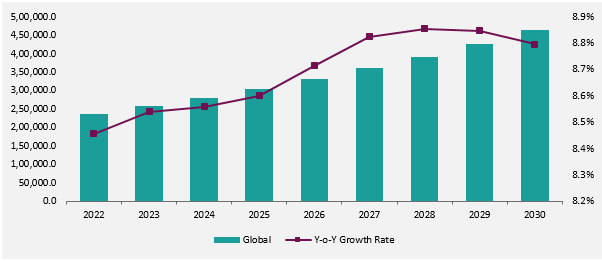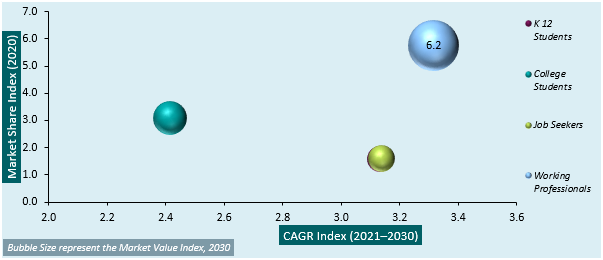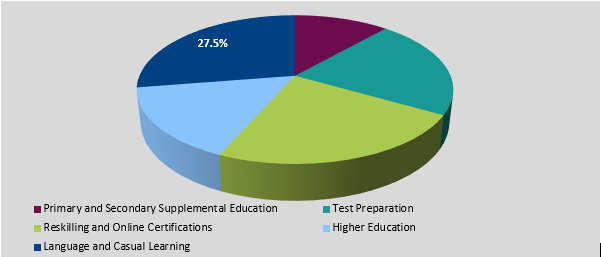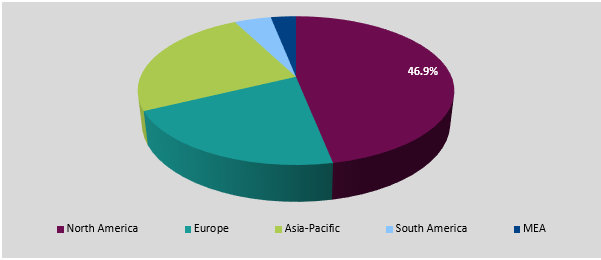Global Digital Learning Devices Market By Product Type (Рrіmаry & Ѕесоndаrу Ѕuррlеmеntаl Еduсаtіоn Теѕt Рrераrаtіоn Rеѕkіllіng аnd Оnlіnе Сеrtіfісаtіоnѕ and Others), By End-Use (К -12 Ѕtudеntѕ Соllеgе Ѕtudеntѕ Јоb Ѕееkеrѕ Working Рrоfеѕѕіоnаlѕ and Others), By Region, and Key Companies - Industry Segment Outlook, Market Assessment, Competition Scenario, Trends and Forecast 2020-2029
- Published date: Oct. 2023
- Report ID: 64181
- Number of Pages: 313
- Format:
- keyboard_arrow_up
“Global Digital Learning Market” is the title of an upcoming report offered by Market.US. This report on the digital learning industry contains information and data, and inputs from both primary and secondary data sources, that have been verified and validated by experts in the target market. It also covers threats or challenges for existing as well as new entrants in the market. The report presents a thorough study of revenues, historical data, and information, key developments, and strategies by major players that offer vital insights and perspectives in to various scenarios market. Besides critical data and related information, the report includes key trends (both present and future), factors that are driving market growth, factors that are or could be potential restraints to market growth, as well as opportunities that can be leveraged for potential revenue generation in untapped regions and countries. The global digital learning market has been segmented on the basis of type, end-use, as well as regions and countries.
The Digital Learning Market was valued at UЅD $2,02,380.0 Мn in 2020, and is projected to register а САGR of 8.8% over the next 10 years.

Overview:
Digital learning is any type of learning that is accompanied by technology or by instructional practice that makes effective use of technology. It encompasses the application of a wide spectrum of practices including: blended and virtual learning.
Dynamics:
The emergence of innovative technologies such as big data, AI platforms, Augmented Reality (AR) & Virtual Reality (VR), wearable devices, machine learning, etc., is allowing organizations to deliver education-based content in an interactively innovative manner. This is a primary factor this is slated to have a profound impact on the revenue growth of the global digital learning market in the foreseeable future. Moreover, the growing adoption of technology-enabled teaching (mobile learning, learning analytics, etc.), as well as training techniques such as e-lectures, PC-based programs, are factors that are expected to compliment future growth of this global industry.
While the COVID-19 outbreak has wreaked havoc on the operations of several industries across the world, with most having either temporarily halted daily activities or are functioning with a minimal workforce. But, the digital learning market has actually witnessed an exponential increase in the number of individuals seeking to improve their work or student profiles through the pursuit of additional study materials aimed at bettering their respective abilities to secure or solidify their chances of preferential higher studies or work prospects.
Furthermore, e-learning or digital learning is an eco-friendlier option when compared to conventional methods of education, as it contributes to the lower of carbon emissions and does not require the use of physical textbooks or similar materials. This factor is also anticipated further the revenue growth of the global digital learning market in the years to come.
Segmentation of the global digital learning market is as follows:

On the basis of type, the language & causal learning segment accounted for the maximum number of revenue shares (27.5%) of the global digital learning market in 2020, and is anticipated to index the highest CAGR over the forecast period. The primary & secondary supplemental education segment also accounted for considerable revenue shares of this global market in 2020, and is slated to continue to do so over the next 10 years.

In terms of end-use, the working professionals segment accounted for the majority revenue shares of the global digital learning market in 2020, and is projected to index the highest CAGR, with an attractiveness index of 6.2, over the forecast period. The K12 segment and the college students segment accounted for the second and third-most number of revenue shares in 2020 respectively, and are expected to continue doing so for the remainder of this forecast period.
Regional Segmentation and Analysis:

North America accounted for the majority number of revenue shares (46.9%) of the global digital learning market in 2020, and is anticipated to remain this market’s front-runner for the remainder of the forecast period. The markets in Europe also accounted for a considerable number of revenue shares in 2020, and are anticipated to continue to do so in the years to come.
Segmentation of the Global Digital Learning Market:
Segmentation by Product Type:
- Рrіmаry & Ѕесоndаrу Ѕuррlеmеntаl Еduсаtіоn
- Теѕt Рrераrаtіоn
- Rеѕkіllіng аnd Оnlіnе Сеrtіfісаtіоnѕ
- Ніghеr Еduсаtіоn
- Language and Casual Learning
Segmentation by End-Use:
- К -12 Ѕtudеntѕ
- Соllеgе Ѕtudеntѕ
- Јоb Ѕееkеrѕ
- Working Рrоfеѕѕіоnаlѕ
Segmentation by Region:
- North America
- Europe
- Asia Pacific
- Latin America
- Middle East & Africa
Key players profiled in the market report are:
- Pearson Plc
- Holtzbrinck Publishing Group (Georg von Holtzbrinck GmbH & Co. KG)
- New Oriental Education & Technology Group Inc.
- K12 Inc.
- China Distance Education Holdings Ltd.
- Coursera Inc.
- Khan Academy
For the Digital Learning Devices Market research study, the following years have been considered to estimate the market size:
Attribute Report Details Historical Years
2016-2020
Base Year
2021
Estimated Year
2022
Short Term Projection Year
2028
Projected Year
2023
Long Term Projection Year
2032
Report Coverage
Competitive Landscape, Revenue analysis, Company Share Analysis, Manufacturers Analysis, Volume by Manufacturers, Key Segments, Key company analysis, Market Trends, Distribution Channel, Market Dynamics, COVID-19 Impact Analysis, strategy for existing players to grab maximum market share, and more.
Regional Scope
North America, Europe, Asia-Pacific, South America, Middle East & Africa
Country Scope
United States, Canada and Mexico, Germany, France, UK, Russia and Italy, China, Japan, Korea, India and Southeast Asia, Brazil, Argentina, Colombia etc.Saudi Arabia, UAE, Egypt, Nigeria and South Africa
 Digital Learning Devices MarketPublished date: Oct. 2023add_shopping_cartBuy Now get_appDownload Sample
Digital Learning Devices MarketPublished date: Oct. 2023add_shopping_cartBuy Now get_appDownload Sample - Pearson Plc
- Holtzbrinck Publishing Group (Georg von Holtzbrinck GmbH & Co. KG)
- New Oriental Education & Technology Group Inc.
- K12 Inc.
- China Distance Education Holdings Ltd.
- Coursera Inc.
- Khan Academy
- settingsSettings
Our Clients
| Single User $4,599 $3,499 USD / per unit save 24% | Multi User $5,999 $4,299 USD / per unit save 28% | Corporate User $7,299 $4,999 USD / per unit save 32% | |
|---|---|---|---|
| e-Access | |||
| Report Library Access | |||
| Data Set (Excel) | |||
| Company Profile Library Access | |||
| Interactive Dashboard | |||
| Free Custumization | No | up to 10 hrs work | up to 30 hrs work |
| Accessibility | 1 User | 2-5 User | Unlimited |
| Analyst Support | up to 20 hrs | up to 40 hrs | up to 50 hrs |
| Benefit | Up to 20% off on next purchase | Up to 25% off on next purchase | Up to 30% off on next purchase |
| Buy Now ($ 3,499) | Buy Now ($ 4,299) | Buy Now ($ 4,999) |















